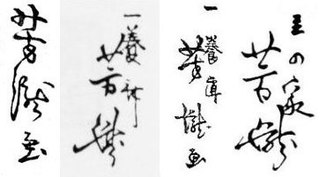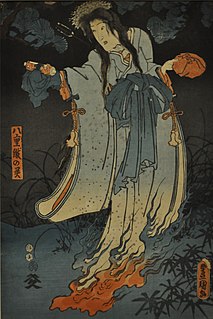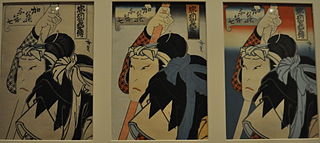
Utagawa Kunisada, also known as Utagawa Toyokuni III, was the most popular, prolific and commercially successful designer of ukiyo-e woodblock prints in 19th-century Japan. In his own time, his reputation far exceeded that of his contemporaries, Hokusai, Hiroshige and Kuniyoshi.

Utagawa Toyokuni, also often referred to as Toyokuni I, to distinguish him from the members of his school who took over his gō (art-name) after he died, was a great master of ukiyo-e, known in particular for his kabuki actor prints. He was the second head of the renowned Utagawa school of Japanese woodblock artists, and was the artist who elevated it to the position of great fame and power it occupied for the rest of the nineteenth century.

Utagawa Kunisada II was a Japanese ukiyo-e print designer, one of three to take the name "Utagawa Kunisada". He headed the Utagawa school.

Konishi Hirosada was the most prolific Osaka-based designer of ukiyo-e woodblock prints during the late Edo period. Like most producers of kamigata-e (上方絵)—prints originating in the Osaka and Kyoto regions—he specialized in yakusha-e actor prints. Hirosada is particularly known for his diptychs and triptychs, and for his many ōkubi-e portraits of the leading actors on the Osaka kabuki stage during his day.
The name Utagawa may refer to:

Utagawa Toyokuni II (1777–1835), also known as Toyoshige, was a designer of ukiyo-e Japanese woodblock prints in Edo. He was the pupil, son-in-law and adopted son of Toyokuni I. The former used the name Toyoshige (豊重) until 1826, the year after his teacher's death, when the family gave him the right to use his teacher's name and he began signing his work Toyokuni (豊国). In 1835 he died, and in 1844 the family persuaded Kunisada, the most famous student of Toyokuni I, to use the name "Toyokuni" and become leader of the school. Although Kunisada never recognised Toyoshige's right to the name Toyokuni, nevertheless Kunisada after 1844 is always referred to as Toyokuni III.

Utagawa Kunimasu was a designer of ukiyo-e woodblock prints in Osaka who was active during the late Edo period. He was a leading producer of kamigata-e, prints from the Osaka and Kyoto areas. He is also known as Sadamasu [貞升], the artist name he used prior to Kunimasu.

Utagawa Yoshitaki, who is also known as Ichiyōsai Yoshitaki, was a Japanese designer of ukiyo-e woodblock prints who was active in both Edo (Tokyo) and Osaka. He was also a painter and newspaper illustrator. His father was a paste merchant, and Yoshitaki became a student of Utagawa Yoshiume (1819–1879). Yoshitaki was the most prolific designer of woodblock prints in Osaka from the 1860s to the 1880s, producing more than 1,200 different prints, almost all of kabuki actors.

Utagawa Toyoharu was a Japanese artist in the ukiyo-e genre, known as the founder of the Utagawa school and for his uki-e pictures that incorporated Western-style geometrical perspective to create a sense of depth.

Female Ghost is an ukiyo-e woodblock print dating to 1852 by celebrated Edo period artist Utagawa Kunisada, also known as Toyokuni III. Female Ghost exemplifies the nineteenth century Japanese vogue for the supernatural and superstitious in the literary and visual arts. The print is part of the permanent collection of the Royal Ontario Museum, Toronto, Canada.

Fan print with two bugaku dancers is an ukiyo-e woodblock print dating to sometime between the mid 1820s and 1844 by celebrated Edo period artist Utagawa Kunisada, also known as Toyokuni III. This print is simultaneously an example of the uchiwa-e and aizuri-e genres. It is part of the permanent collection of the Royal Ontario Museum, Toronto, Canada.

The two ukiyo-e woodblock prints making up View of Tempōzan Park in Naniwa are half of a tetraptych by Osaka artist Gochōtei Sadamasu. They depict a scene of crowds visiting Mount Tempō in springtime to admire its natural beauty. The sheets belong to the permanent collection of the Royal Ontario Museum, Canada.

Bust portrait of Actor Kataoka Ichizō I is an ukiyo-e woodblock print belonging to the permanent collection of the Royal Ontario Museum, Canada. The print dates to around the mid nineteenth century, and is an example of kamigata-e, prints produced in the Osaka and Kyoto areas. The ROM attributes the print to Utagawa Sadamasu II, but other institutions identify Utagawa Kunimasu—also known as Sadamasu I—as the artist.

Ryūsai Shigeharu (柳窗重春/柳斎重春) (1802–1853) was an Osaka-based Japanese ukiyo-e woodblock print artist active during the first half of the nineteenth century. A member of the Utagawa school, he was one of a very select group of kamigata-e print artists who were able to support themselves solely as professional artists.

Actor Ichikawa Shikō as Katō Yomoshichi from the series Tales of Retainers of Unswerving Loyalty is an ukiyo-e woodblock print by Osaka-based late Edo period print designer Gosōtei Hirosada (五粽亭廣貞). Each of the three sheets contains a different version of the same image, reflecting progressive stages in the woodblock printing process. The print is a portrait of a contemporary kabuki actor in the role of a samurai, and belongs to a series of images of heroes. The print belongs to the permanent collection of the Prince Takamado Gallery of Japanese Art in the Royal Ontario Museum, Canada.

Actor Ichikawa Ebijūrō as Samurai is an ukiyo-e Japanese woodblock print by Osaka-based late Edo period print designer Shunshosai Hokuchō. The print depicts a scene from a kabuki play featuring Osaka actor Ichikawa Ebijūrō (市川蝦十郎) in the role of a samurai. One impression of the print belongs to the permanent collection of the Prince Takamado Gallery of Japanese Art in the Royal Ontario Museum, Canada.

Shunshosai Hokuchō was a Japanese ukiyo-e woodblock print artist active in the Osaka area during the first half of the nineteenth century. He was a member of the Shunkōsai Fukushū school of artists, and studied under Shunkōsai Hokushū (春好斎北洲). His original surname was Inoue (井上), and he used the gō art names Shunsho (春曙) (1822-1824), Hokuchō (北頂) (1824-1830), Inoue Shunshosai (井上春曙斎).

Utagawa Sadahide, also known as Gountei Sadahide, was a Japanese artist best known for his prints in the ukiyo-e style as a member of the Utagawa school. His prints covered a wide variety of genres; amongst his best known are his Yokohama-e pictures of foreigners in Yokohama in the 1860s, a period when he was a best-selling artist. He was a member of the Tokugawa shogunate's delegation to the International Exposition of 1867 in Paris.
References can be found under each entry.

















